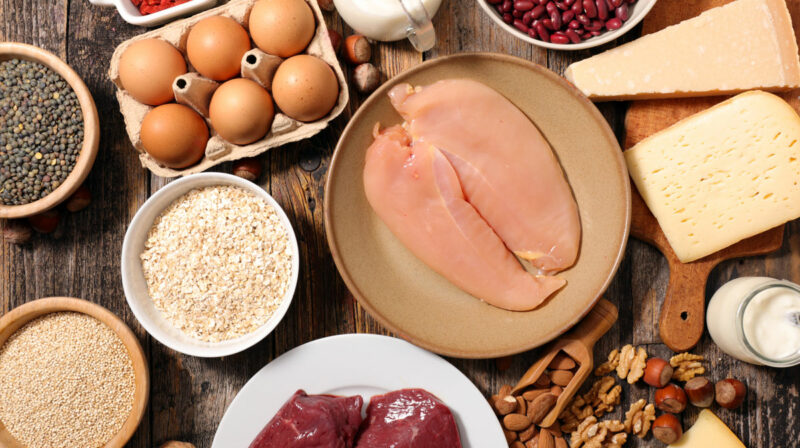Building Muscle with Protein: Why, What, and How Much?
This article is verified by 5 studies/publications.

Protein is a macronutrient composed of amino acids, essential for our bodies. Found in all our cells, muscles are primarily made of protein, emphasizing its importance for strength training and muscle building.
While many think of protein supplements like whey, casein, and plant-based powders for strength training, it’s crucial to focus on overall nutrition and protein intake from “normal” foods like eggs, fish, or meat. But how much protein do we actually need? What’s the right amount for muscle building? And which foods are good protein sources? Let’s answer these important questions.
How much protein does a person need?
There’s no definitive answer to the optimal protein amount. Even the recommended dietary allowances for sedentary people vary.
The American Academy of Nutrition and Dietetics[1] and the German Society for Nutrition[2] suggest a protein intake of 0.8 grams per kilogram of body weight for sedentary adults. For a 70 kg person, that’s 56 grams of protein daily.
However, these recommendations aren’t set in stone. A 2010 review[3] estimated a daily requirement for adults of 0.93 to 1.2 g/kg.
How much protein for muscle building?
There’s no unified recommendation for muscle building through strength training.
A 2017 systematic review examined protein intake’s effect on muscle growth, concluding that a maximum of 1.6 g/kg per day was needed for muscle growth. Consuming more than that didn’t impact muscle growth, according to the analysis, which mostly included studies on untrained adults in a calorie surplus.
The American College of Sports Medicine recommends that physically active people consume 1.2 g/kg to 1.7 g/kg of protein daily.
In a 2018 publication, the authors concluded that elite athletes need 1.6 g/kg to 2.4 g/kg of protein daily. This recommendation is at the lower end of the previously mentioned suggestion, with the authors noting that protein requirements depend on calorie deficits and training intensity.
Some studies base their research on lean body mass instead of body weight, but this complicates determining optimal protein intake, as it requires precise determination of body fat percentage.
Health disadvantages of high protein intake?
When protein intake is excessively high, one might wonder if there could be negative effects. Various studies and analyses explore this topic.
A 2018 meta-analysis of 28 studies concluded that higher protein intake did not negatively impact kidney function or the glomerular filtration rate (GFR). High-protein diets, however, led to higher GFR values. Higher protein intake was defined as more than 1.5 g/kg, more than 20% of energy needs, or more than 100 g total protein intake per day.
A 2021 study on mice models showed that an extremely high protein intake over 24 weeks can indeed harm the kidneys[4].
The gut is often overlooked in such recommendations. However, it’s essential to consider the microbiome – the composition of gut bacteria necessary for proper digestion and numerous other body processes – when consuming protein. A 2018 publication highlights the potential negative impact of high protein intake on the microbiome[5].
High protein quantities in the diet can change the composition of the microbiome, increasing the proportion of harmful bacteria due to undigested proteins. This can lead to bloating, diarrhea, and potentially systemic health issues over time. The aforementioned study on mice also concludes that a high protein intake alters the microbiome and weakens the gut barrier.
Summary
There is no one-size-fits-all rule. The optimal amount of protein depends on the level of physical activity. The more intense the activity, the more protein is needed to meet muscle demands. Most recommendations agree on this.
For the exact amount, it’s best to follow a middle ground based on current research and recommendations. The upper limit of 1.6 g/kg of daily protein in one analysis is the lower limit in another. This seems to be a good value to achieve growth effects without exposing oneself to the potentially negative effects of significantly increased protein intake.
In any case, always listen to your body. Don’t ignore digestive problems, bloating, and diarrhea with high protein intake.
Sources
- Protein intake for optimal muscle maintenance. Donna Cataldo, Matthew Blair. American College of Sports Medicine. 2015. URL: https://www.acsm.org/docs/default-source/files-for-resource-library/protein-intake-for-optimal-muscle-maintenance.pdf, accessed on 07.11.2021
- Protein. Deutsche Gesellschaft für Ernährung e. V. 2017. URL: https://www.dge.de/wissenschaft/referenzwerte/protein/, accessed on 07.11.2021
- Evidence that protein requirements have been significantly underestimated. Elango, R., Humayun, M. A., Ball, R. O., & Pencharz, P. B. Current Opinion in Clinical Nutrition and Metabolic Care. 2010 13(1), 52–57. doi:10.1097/mco.0b013e328332f9b7
- Long Term High Protein Diet Feeding Alters the Microbiome and Increases Intestinal Permeability, Systemic Inflammation and Kidney Injury in Mice. Snelson, M., Clarke, R. E., Nguyen, T., Penfold, S. A., Forbes, J. M., Tan, S. M., & Coughlan, M. T. Molecular Nutrition & Food Research. 2021. 65(8), 2000851. doi:10.1002/mnfr.202000851
- Dietary Protein and Gut Microbiome Composition and Function. Zhao, J., Liu, H., Michael, A. B., & Qiao, S. Current Protein & Peptide Science, 19. 2018. doi:10.2174/1389203719666180514145437